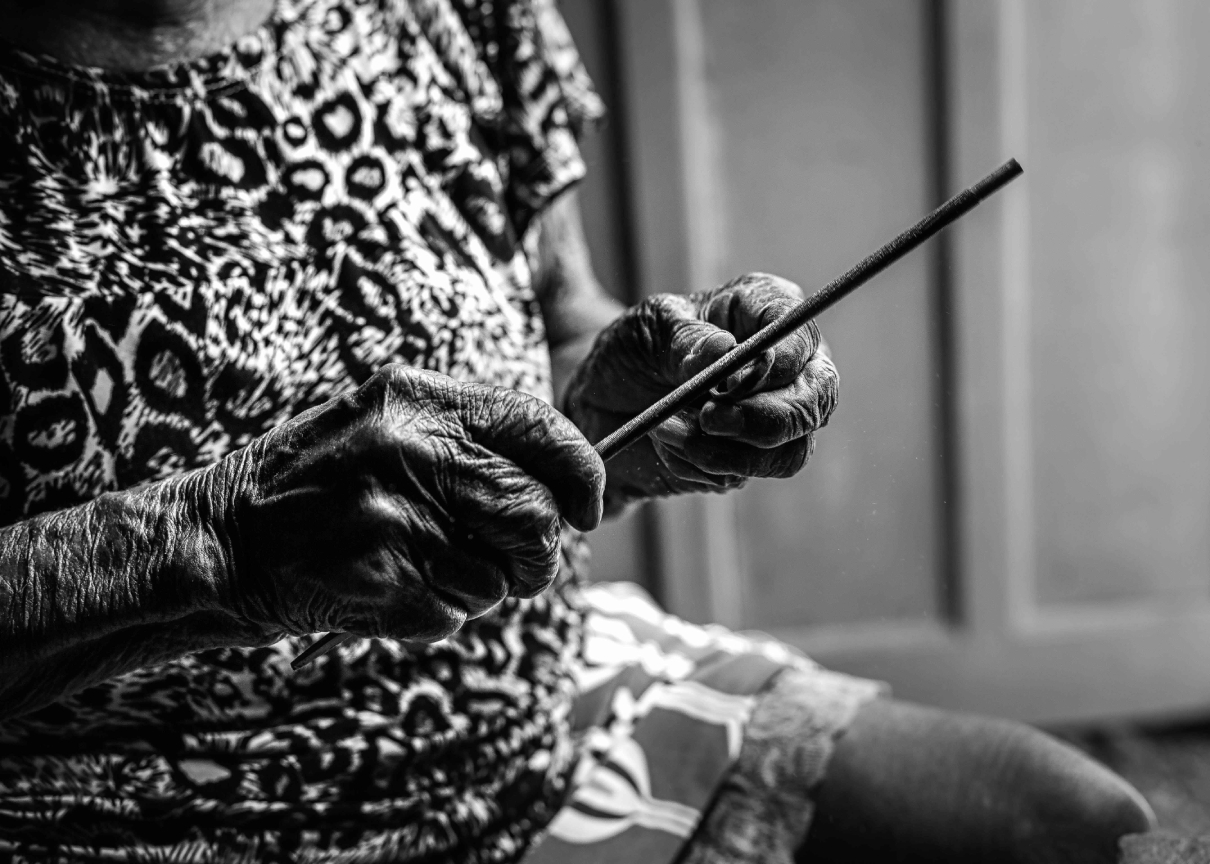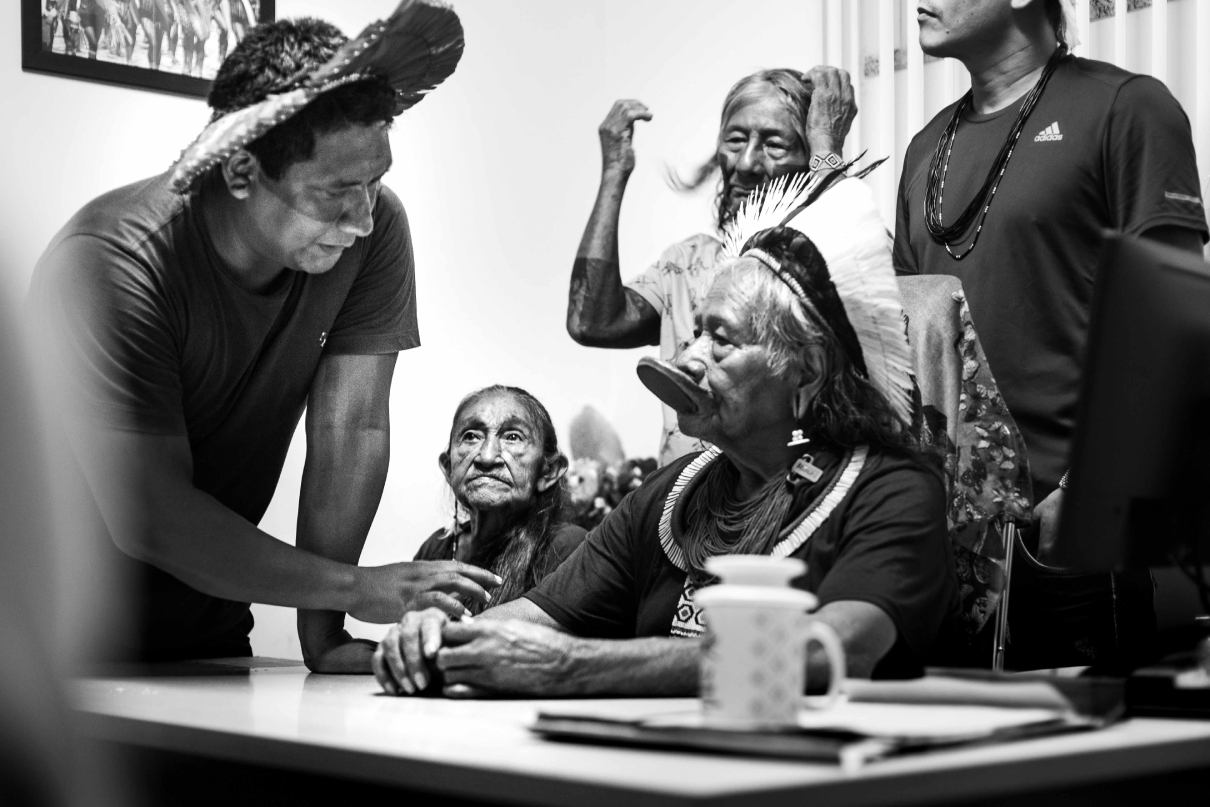- Languages are going extinct at a breakneck pace: Of the nearly 7,000 languages in the world today, around 25% are now in danger of disappearing, a higher percentage than extinction among mammals (21%), reptiles (15%) or birds (13%).
- Specific knowledge is often held by the shrinking Indigenous communities, such as knowledge of medicinal plants and cures, or the identification of plants and animals not yet known to science.
- When a language is not learned by the next generation, the knowledge of the natural and cultural world encoded in it typically fails to be transmitted.
- Community-led approaches such as Indigenous biocultural heritage territories can provide more equitable, effective and low-cost alternatives to protected areas.
Iawá, also known as Odete Kuruaya, is the last remaining fluent speaker of the Kuruaya language.
Not much is known of the Kuruaya, an Indigenous group from the Amazon Rainforest. They were first described in a document from the expedition of the Portuguese settler Gonçalves Paes de Araújo in 1685, who mentioned that they were scattered across 20 villages in the Xingu River region in Brazil.
Born in the early 1930s to a Kuruaya mother and a Xipaya father, Iawá and her family lived off the land, hunting and fishing, while cultivating a few crops such as cassava, corn, cotton and others, as she described in an interview in 2016.

She married as a teenager, and soon after both she and her husband were forced to work for non-Indigenous people, a fate many other Indigenous people endured at that time. For decades they were part of a seasonal working group that harvested products from the forest, such as nuts, rubber, or the pelts of wild cats. This was known as aviamento, a form of barter where the worker exchanged the products of their efforts for other goods, according to Iawá. The boss or trader would set the price, and in case of conflict they would act at as the police via their foremen, and also as the judge.
In 1980, Iawá finally managed to get hold of one of her ancestor’s lands and secured the official land title from the Brazilian authorities. Since then, she has lived with her family in the Great Bend of Xingu, a 130-kilometer (80-mile) stretch of land where the river twists and turns dramatically in serpentine-like curves, before joining the great Amazon River.

But a few years ago, the third-largest hydroelectric dam in the world, Belo Monte, was built a few miles from her territory. When the dam went into operation in 2016, it created a severe impact in the region.
Hundreds of families, including from the Indigenous Kuruaya, Juruna, Arara, and Xipaya communities, began experiencing water shortages, and say they witnessed a massive death of fish, a steep decline in the numbers of animals to hunt, and a perilous change in the quality of the river’s water. Iawá, already forced early on out of her Indigenous way of life and made to abandon her family, was now at the mercy of the new owners of the land.
The Kuruaya as an ethnic group have for a long time been dispersed, their numbers dwindling, without support or acknowledgment from the government. The construction of the dam would be just the latest massive disruption to their traditional livelihood.

Cultural preservation and biodiversity
Environmental damage goes hand in hand with the annihilation of cultural biodiversity, according to experts. A report from 2014, commissioned by WWF, found that 25% of the world’s 7,000 languages are now in danger of extinction — a higher percentage than among mammals (where 21% are at threat of extinction), reptiles (15%) or birds (13%).
The Kuruaya language is now classified as on the verge of extinction by Brazilian linguistics researchers.
Declines in linguistic diversity are linked with social, political and economic behaviors, such as forced migration or urbanization. Philip Fearnside, an Amazon researcher who was part of the Intergovernmental Panel on Climate Change that won the Nobel Peace Prize in 2007, supported that conclusion in 2015. He noted that forest loss caused by massive dam projects, along with the dismantling of protective laws and regulations, imperil Indigenous peoples in particular.

When Mongabay met and interviewed Iawá at her home over the course of several days in 2019, she spoke about the sacredness of the Xingu River to Indigenous peoples, and of their vital connection to the land.
For Indigenous communities, language and land are closely intertwined. Throughout most of her life, Iawá was forced to move from place to place, and her experience became more and more distant from her Indigenous upbringing, from the transcendent aspects in life — rites and traditions — thus contributing to her community’s cultural loss.
Biodiversity, on which humanity depends, is being lost at an extraordinary rate, alongside the rapidly shrinking diversity of human cultures. A recent report from the International Institute for Environment and Development (IIED) notes the significance of biocultural community-led approaches used by Indigenous populations to manage the landscapes. These are projects that are able to sustain biodiversity and avoid negative social impacts.
Krystyna Swiderska, a principal researcher at IIED’s Natural Resources Group, said in an interview that cultural values are key. “Cultural values of Indigenous peoples around the world are known to promote balance and protection of nature,” she said. “We need more research on Indigenous crops and farming systems, and on their importance for long term food security, nutrition and resilience to climate change.”

Hope for change?
In 2021, governments across the world are slated to agree to a new set of post-2020 targets for addressing biodiversity loss, during the Convention on Biological Diversity. One of the goals, according to the IIED’s report, is to be effective and equitable, particularly with regard to Indigenous peoples, who the report notes are “custodians of around 80% of the world’s biodiversity.”
Questions remain over whether there can be a positive outcome for the Kuruaya and other Indigenous groups in a similar situation. Swiderska said she’s not optimistic.
“I don’t think so, sadly,” she said. “Although the Biodiversity Convention requires countries to respect, preserve and maintain traditional knowledge and customary use of biodiversity — these requirements are not well implemented in many countries.”
Swiderska said the convention mainly targets biodiversity and not cultural diversity and heritage, “even though the two are closely interlinked.”
“To prevent loss of culture/languages, we need to protect the rights of Indigenous peoples to their territories, to strengthen their organizations and their participation in policy making, and promote inter-generational transmission of culture,” she added.
Banner image: The Kuruaya use a local fruit called urucu for its natural red pigment, which they use to paint their faces. Each Indigenous nation has its own traditional drawings and symbols, taught from an early age. The paintings have both aesthetic and symbolic meanings. Lorena Kuruaya, Iawá’s granddaughter, crushes urucu seeds. Photo by Miguel Pinheiro.
